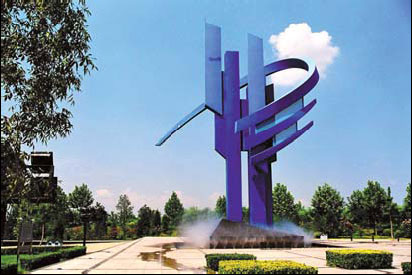News
Zhongguancun to expand innovative capacity
By Zhang Zhao (China Daily)
Updated: 2010-09-15 07:56
 |
Large Medium Small |
|
The Zhongguancun Financial Corridor, running from Wanquanhe Road to Xueyuan Road, spans four km. Beijing officials expect the financial sector in Zhongguancun will rival its technology industry in terms of profit. Photos provided to China Daily |
With more than 1 million talented employees and nearly 20,000 enterprises, Zhongguancun is one of China's largest and most important high-tech bases.
Around 101 Fortune 500 companies have set up research and development centers in the area, along with several innovative Chinese corporations including Lenovo, Founder, and Baidu.com.
The electronics, new materials, bio-pharmaceuticals, and aerospace industries all call Zhongguancun home.
Last April, central government officials announced plans to build a Zhongguancun national innovation model park.
Already, Zhongguancun companies are carrying out 25 percent of all 863 program projects, part of a national long-term scientific research and development plan.
Businesses in the area have won the National Prize for Progress in Science and Technology more than 50 times.
Nearly 110,000 patents have been filed by Zhongguancun enterprises, with more than 590 national standards and 30 internationally recognized standards including TD-SCDMA, McWiLL and IGRS.

Over the past year, government has been paying more attention to emerging industries such as cloud computing, aerospace engineering, network integration and wind and nuclear power.
Sinovel Wind Group has developed China's most powerful offshore wind turbine, while Baidu Inc has made great progress in cloud computing.
VinnoTech Inc has developed a wireless transmitting system based on networked connections between everyday objects. It has also acquired international standards.
A number of new products and technologies have already been put to use at the Olympic Games, on China's manned space flight, Qinghai-Tibet railway and nuclear power stations. They have also aided sustainable energy and disaster prevention efforts.
The torches used in the Beijing Olympics borrowed technology developed by Haiying Group. The giant LED displays on Tiananmen Square during the 2009 National Day parade were from Leyard.
Sinovac Biotech created the world's first SARS vaccine in 2004. Xinwei Telecom Technology provided McWiLL wireless broadband systems and emergency communication trucks for the 2008 Sichuan earthquake relief work.
Pulead Technology Industry's high-performance lithium-ion battery is helping reduce emissions, and home-made CPUs from Loongson Technology have been put in use for national security service.
Zhongguancun companies signed contracts worth more than 80 billion yuan in the first six months of this year, up 76.8 percent from the same period of 2009.
Almost 42 billion yuan came from investors outside Beijing, while 29 billion yuan came from abroad, nearly tripling last year's figure.
Building capital
Zhongguancun will build two new high-tech clusters. The northernmost industries, based in Haidian and Changping districts, will emphasize innovation and financial services.
A Zhongguancun science town will be located near Zhichun and Xueyuan roads in Haidian. It will cover 75 sq km, transforming science and technology to products and profit, said officials.
Industries to the south, based in Tongzhou and Daxing districts, will focus on bio-pharmaceuticals, new materials and environmental protection.
Currently, Zhongguancun has 152 listed companies with a total market value of more than 1 trillion yuan. Around 30 of those businesses have market values in excess of 10 billion yuan.
Of China's 90 companies listed in the Growth Enterprise Market (GEM), more than 20 are based in Zhongguancun.
Financial institutions including the Bank of Beijing and the Bank of Communication offer more than 30 billion yuan in financial funding to businesses in the zone.
Zhongguancun now has a reformed business administration system, complete with 43 new registration, trade mark and credit system policies. Further, the administrative examination and approval system of the park was simplified.
Now, with a "special zone, special policies, and special mechanisms," said officials, China can attract more talented people. They expect new recruits to boost the nation's number of self-developed high-tech products.
Liu Chuanzhi, chairman of Lenovo, and Li Yanhong, CEO of Baidu, are among 40 Zhongguancun workers identified by the "1,000-talent scheme."
A nationwide plan launched in 2008, the scheme promises top salaries and attractive funding to elites who are working overseas and willing to come or return to China.
|
The Zhongguancun Square. |
(China Daily 09/15/2010)

